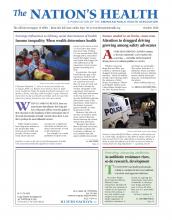As drunken driving crashes continue to decrease nationwide, a new roadway risk is growing — and unlike alcohol-impaired driving, there is no national guideline to corral it.
Whether caused by drugs that are illicit, prescribed or otherwise legal, drugged driving is gaining attention. About 10 million people report driving under the influence of illicit drugs, according to “Behavioral Health Trends in the United States: Results from the 2014 National Survey on Drug Use and Health.” The report, from the U.S. Substance Abuse and Mental Health Services Administration, details Americans’ drug use, including behind the wheel.

Monroe County Sheriff Luis Blasco conducts a field sobriety test at a DUI traffic checkpoint in July 2007 in Miami. While such tests are used by U.S. law enforcement to determine whether a driver is under the influence of alcohol, no such tool exists for testing drivers for drug impairment — a growing concern.
Photo by Joe Raedle, courtesy Getty Images
About 4,000 people are killed every year in traffic crashes in which a driver was on the road with drugs in her or his system. But public health experts say that number may be much understated, downplaying the possible risk to drivers and pedestrians alike.
Not every state requires drug testing in the event of a fatal crash. But according to a study published in 2014 in Public Health Reports, the states that do test for drugs after a fatality found 47 percent had used a prescription drug, 37 percent had used marijuana and 10 percent had used cocaine. The most common prescription drugs found in victims’ systems were opioids or other pain relievers.
As public health joins with other partners to address the nation’s opioid epidemic, and grapples with how to make legal marijuana use safer, the subject of drugged driving continues to come up. Unlike alcohol-impaired driving, now identified as dangerous and regulated by states’ 0.08 blood alcohol content limit, there are no such across-the-board regulations targeting drugged driving. And states are in a pickle: As there is not much research available on drugged driving, legislators do not have the data to set possible limits — but without testing and limit guidelines, data is not being collected for research.
Debbie Hersman, MS, president and chief executive officer of the National Safety Council and an APHA member, said that catch-22 is putting people at risk every time they take to the streets.
“When we talk about alcohol, everybody kind of knows” what the limits are, and how to test drivers, Hersman told The Nation’s Health.
“With drugs, we’re talking about a whole universe of things that people can smoke, ingest, inject,” she said. “There are illicit drugs, but then…some are legal. This is a really huge space to talk about.”

City of North Miami Beach police officer Duhamel Jeanite conducts a field sobriety test at a DUI checkpoint in May 2013 in Miami. While all states and the District of Columbia bar driving with a blood alcohol concentration at or above 0.08 percent, there are no such across-the-board limits for drugged driving.
Photo by Joe Raedle, courtesy Getty Images
Rallying public health around a prevention model can be difficult, experts say, because drugged driving encompasses legal and illegal substances, and those substances can affect people in different ways. Bella Dinh-Zarr, PhD, MPH, vice chair of the National Transportation Safety Board and an APHA member, said that although prevention models and scientific data have helped back up drunken driving prevention campaigns, people often do not realize the risks they take with drugged driving.
“The United States has a rapidly aging baby boom generation and that means more drivers may be using over-the-counter or prescription drugs,” she told The Nation’s Health. “Many over-the-counter medications advise against operating ‘heavy machinery’ and people often forget that a car is a heavy piece of machinery.”
While breathalyzers, and roadside sobriety field tests before them, have long been used by U.S. law enforcement to determine whether or not a driver is under the influence of alcohol, no such uniform tool exists for testing drivers for drug impairment. There is no one standard tool available to law enforcement to allow for scientific data collection when it comes to drug use. As there is no national standard, there also is no standard way to test for drugged driving. Blood, oral fluid and urine tests can all be used to check for the presence of drugs in a driver’s system, but those would not tell the whole story, Hersman said.
“One of the big concerns that we have now is that the positive test doesn’t mean (a drug) was impacting the driver at the time of the crash,” she said. “There’s no national policy that’s followed by states or municipalities. We really have a patchwork system across the country.”
Hersman said that public health advocates need to come to a consensus on a national standard for drugged driving limits and testing. The National Safety Council is working to make such a standard a reality.
There is also little motivation to test for drugs’ presence in the aftermath of many crashes. According to the National Highway Traffic Safety Administration, police often do not test for drugs if drivers have reached an illegal blood alcohol concentration, as that alone means that the driver is guilty of driving while intoxicated.
NHTSA is working with the International Association of Chiefs of Police to provide law enforcement officers with training on the identification of drug impairment, such as Drug Recognition Expert training, which provides more advanced training to law enforcement officers who can conduct assessments in a controlled environment, such as a detention facility.
“We are still in the learning phase about drugged driving so there isn’t a silver technology bullet that I can think of at the moment,” Dinh-Zarr said. “The way that drugs, especially synthetic drugs that are becoming more popular, bind to receptors is quite unpredictable — and therefore a person’s reaction to them is unpredictable. To make it worse, the chemistry of synthetic drugs (is) constantly changing — oftentimes on purpose to avoid detection — so we can’t always test for some drugs easily, or sometimes at all.”
As law enforcement and public health work together to grapple with drugged driving, another issue is arising: Many of the drugs that impair drivers are legal. Marijuana, in particular, is cause for concern: An August Gallup poll found that one in eight U.S. adults smokes marijuana, and only nine states have total bans on possession or use of marijuana. In the states where marijuana has been legalized or decriminalized, crash numbers involving the drug are increasing, Hersman said.
In fact, May research from the AAA Foundation for Traffic Safety found that crashes among drivers who used marijuana doubled in Washington after the state legalized the drug.
Public health can take action to make the roadways safer for all, Dinh-Zarr said, by supporting better and more standardized toxicology testing, including types of drugs. Support is also needed for lab methods and cut-off values for positive results, both for drivers identified by police and for fatally injured drivers, to improve data and help set nationwide guidelines.
Attendees at APHA’s 2016 Annual Meeting and Expo, held Oct. 29-Nov. 2 in Denver, will have two chances to learn more about drugged driving. Session 3318 on Monday, Oct. 31, will explore what legalizing marijuana means for communities, on and off the road. Session 4206.1 on Tuesday, Nov. 1, moderated by Dinh-Zarr, will discuss safety measures.
For more information on drugged driving, visit www.drugabuse.gov.
- Copyright The Nation’s Health, American Public Health Association









